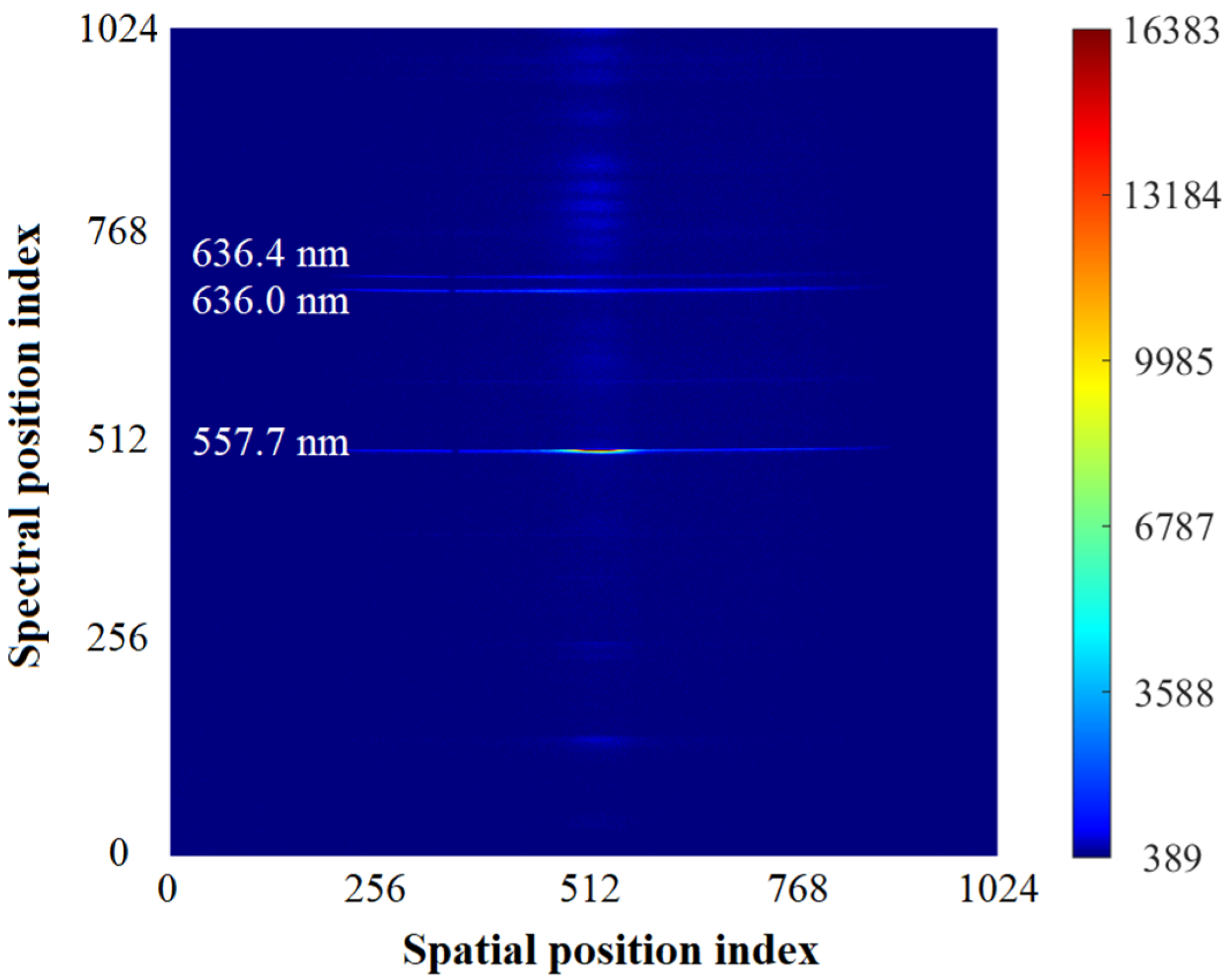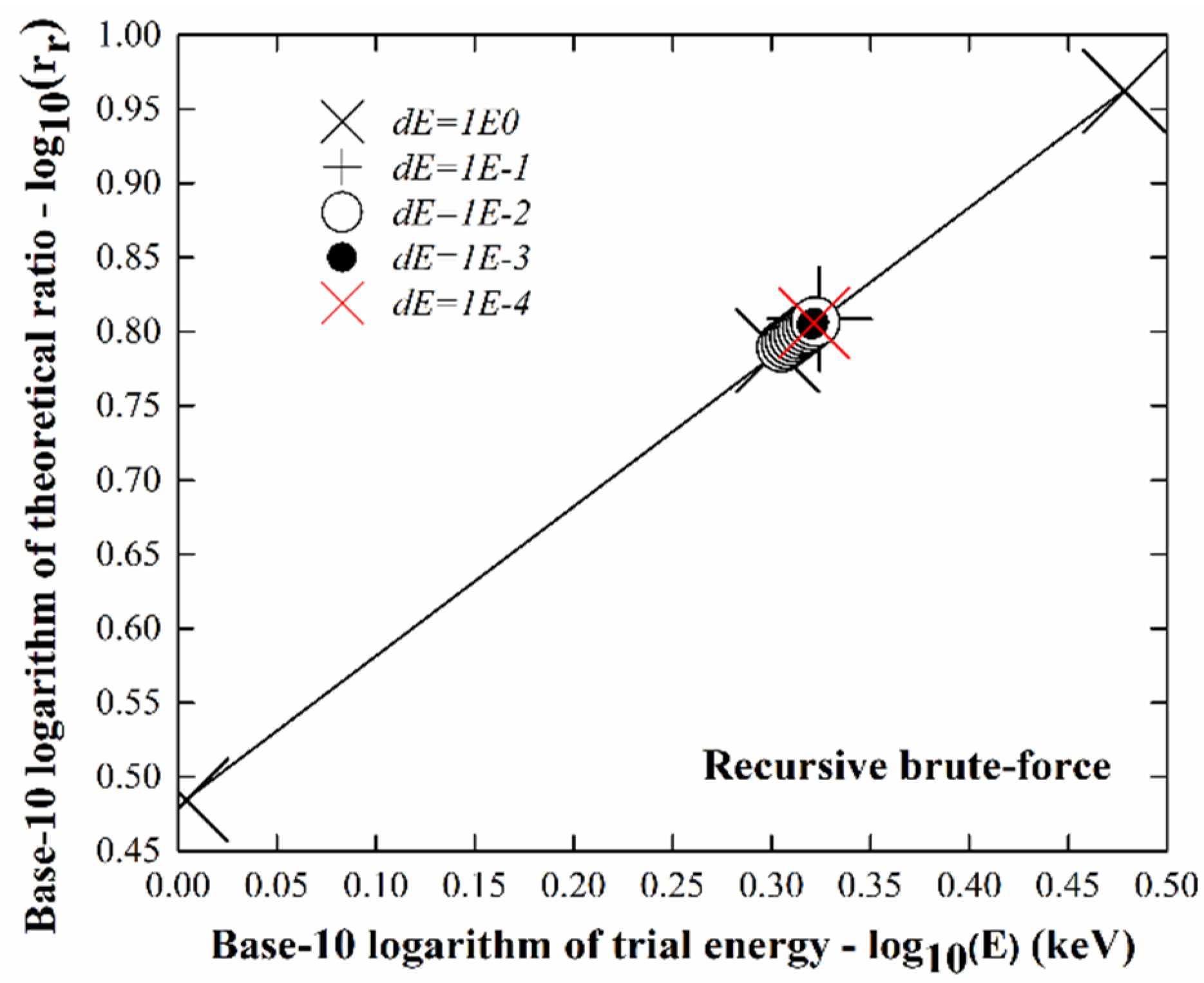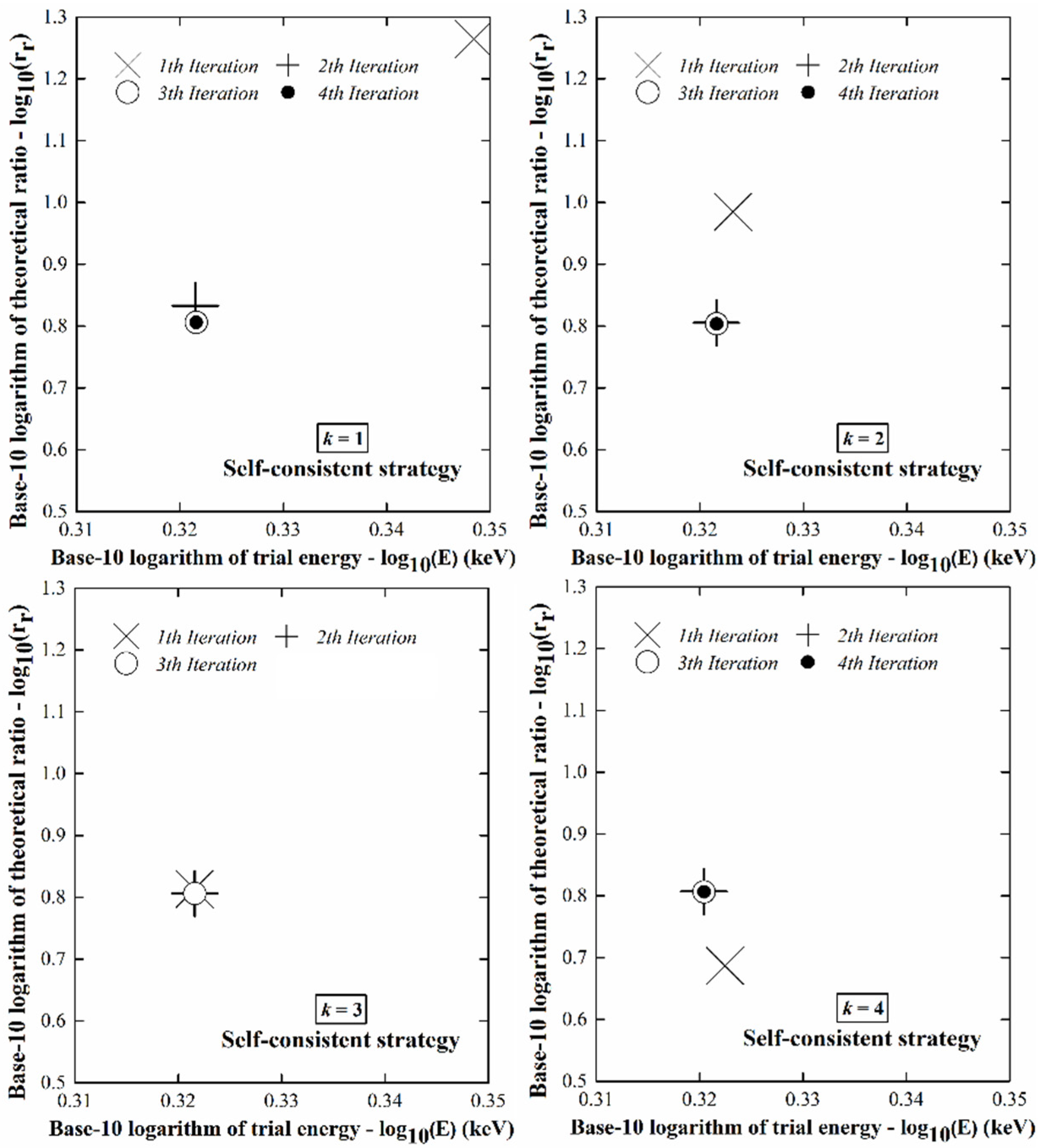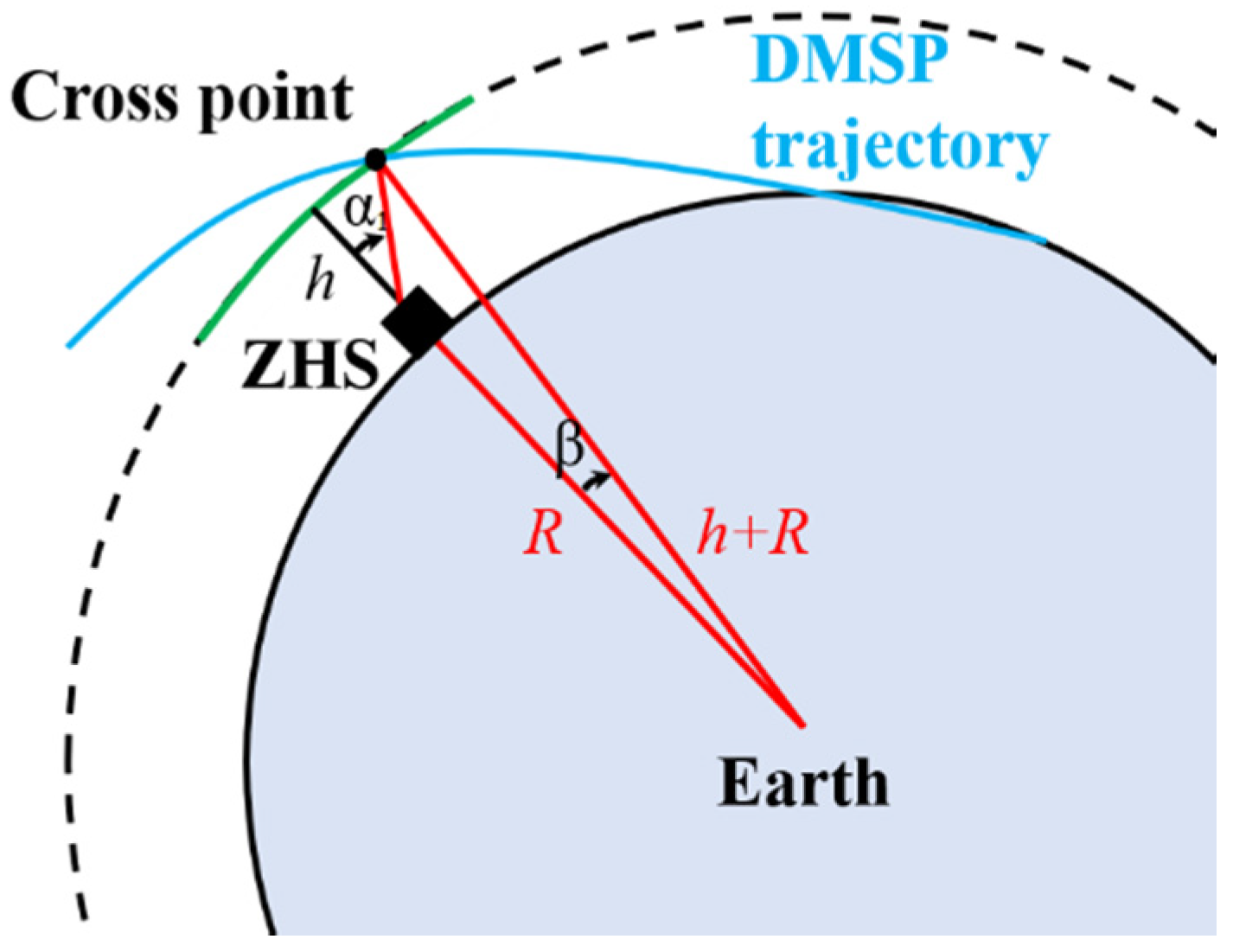A Comparative Study of Estimating Auroral Electron Energy from Ground-Based Hyperspectral Imagery and DMSP-SSJ5 Particle Data
Abstract
1. Introduction
2. Ground-Based Hyperspectral Imagery
3. The Scheme to Estimate the Precipitating Electron Energy
3.1. Schematic Diagram and Some Basic Concepts
3.2. The Modified Rees’s Electron Transport Model
3.3. Approximation Strategies
3.3.1. Classical Brute-Force Approximation
3.3.2. Recursive Brute-Force Approximation
| Algorithm 1. The brute-force strategy |
| Input: The true intensity ratio Output: The trial characteristic energy Initialize: , , , , Algorithm: while do while do if then break end if if and then break end if end while end while |
3.3.3. Recursive Brute-Force Approximation
| Algorithm 2. The recursive strategy. |
| Input: The true intensity ratio Output: The trial characteristic energy Initialize: , Algorithm: while do end while |
4. An Example—Derivation
5. Experimental Studies
5.1. Joint Observations by ASG and DMSP SSJ5
5.2. Estimation Concerning the Particle Energy Data Detected by SSJ5
5.3. Comparative Estimations Based on the Joint Observations
6. Conclusions
Author Contributions
Funding
Acknowledgments
Conflicts of Interest
References
- Ergun, R.; Andersson, L.; Main, D.; Su, Y.J.; Newman, D.; Goldman, M.; Carlson, C.; Hull, A.; McFadden, J.; Mozer, F. Auroral particle acceleration by strong double layers: The upward current region. J. Geophys. Res. Space Phys. 2004, 109, A12220. [Google Scholar] [CrossRef]
- Newell, P.T.; Sotirelis, T.; Wing, S. Diffuse, monoenergetic, and broadband aurora: The global precipitation budget. J. Geophys. Res. Space Phys. 2009, 114, A09207. [Google Scholar] [CrossRef]
- Ni, B.; Thorne, R.M.; Zhang, X.; Bortnik, J.; Pu, Z.; Xie, L.; Hu, Z.-J.; Han, D.; Shi, R.; Zhou, C. Origins of the Earth’s diffuse auroral precipitation. Space Sci. Rev. 2016, 200, 205–259. [Google Scholar] [CrossRef]
- Sandholt, P.; Farrugia, C.; Stauning, P.; Cowley, S.; Hansen, T. Cusp/cleft auroral forms and activities in relation to ionospheric convection: Responses to specific changes in solar wind and interplanetary magnetic field conditions. J. Geophys. Res. Space Phys. 1996, 101, 5003–5020. [Google Scholar] [CrossRef]
- Kozlovsky, A.; Safargaleev, V.; Østgaard, N.; Turunen, T.; Koustov, A.; Jussila, J.; Roldugin, A. On the motion of dayside auroras caused by a solar wind pressure pulse. Ann. Geophys. 2005, 23, 509–521. [Google Scholar] [CrossRef]
- Milan, S.E. Sun et Lumière: Solar wind-magnetosphere coupling as deduced from ionospheric flows and polar auroras. In Proceedings of Magnetospheric Plasma Physics: The Impact of Jim Dungey’s Research; Springer: Cham, Switzerland, 2015; pp. 33–64. [Google Scholar]
- Onsager, T.; Grubb, R.; Kunches, J.; Matheson, L.; Speich, D.; Zwickl, R.W.; Sauer, H. Operational uses of the GOES energetic particle detectors. In GOES-8 and Beyond; International Society for Optics and Photonics: Bellingham, WA, USA, 1996; pp. 281–290. [Google Scholar]
- Sauvaud, J.; Moreau, T.; Maggiolo, R.; Treilhou, J.-P.; Jacquey, C.; Cros, A.; Coutelier, J.; Rouzaud, J.; Penou, E.; Gangloff, M. High-energy electron detection onboard DEMETER: The IDP spectrometer, description and first results on the inner belt. Planet. Space Sci. 2006, 54, 502–511. [Google Scholar] [CrossRef]
- Nesse Tyssøy, H.; Sandanger, M.I.; Ødegaard, L.K.; Stadsnes, J.; Aasnes, A.; Zawedde, A. Energetic electron precipitation into the middle atmosphere—Constructing the loss cone fluxes from MEPED POES. J. Geophys. Res. Space Phys. 2016, 121, 5693–5707. [Google Scholar] [CrossRef]
- Woodger, L.; Halford, A.; Millan, R.; McCarthy, M.; Smith, D.; Bowers, G.; Sample, J.; Anderson, B.; Liang, X. A summary of the BARREL campaigns: Technique for studying electron precipitation. J. Geophys. Res. Space Phys. 2015, 120, 4922–4935. [Google Scholar] [CrossRef] [PubMed]
- Janhunen, P. Reconstruction of electron precipitation characteristics from a set of multiwavelength digital all-sky auroral images. J. Geophys. Res. Space Phys. 2001, 106, 18505–18516. [Google Scholar] [CrossRef]
- Hu, Z.J.; Yang, H.; Liang, J.; Han, D.; Huang, D.; Hu, H.; Zhang, B.; Liu, R.; Chen, Z. The 4-emission-core structure of dayside aurora oval observed by all-sky imager at 557.7nm in Ny-Ålesund, Svalbard. J. Atmos. Sol. Terr. Phys 2010, 72, 638–642. [Google Scholar] [CrossRef]
- Rees, M.H.; Luckey, D. Auroral electron energy derived from ratio of spectroscopic emissions 1. Model computations. J. Geophys. Res. 1974, 79, 5181–5186. [Google Scholar] [CrossRef]
- Jones, R.A.; Rees, M.H. Time dependent studies of the aurora—I. Ion density and composition. Planet. Space Sci. 1973, 21, 537–557. [Google Scholar] [CrossRef]
- Rees, M.H.; Jones, R.A. Time dependent studies of the aurora—II. Spectroscopic morphology. Planet. Space Sci. 1973, 21, 1213–1235. [Google Scholar] [CrossRef]
- Grubbs, G.; Michell, R.; Samara, M.; Hampton, D.; Jahn, J.M. Predicting electron population characteristics in 2-D using multi-spectral ground-based imaging. Geophys. Res. Lett. 2018, 45, 15–20. [Google Scholar] [CrossRef]
- Grubbs, G.; Michell, R.; Samara, M.; Hampton, D.; Hecht, J.; Solomon, S.C.; Jahn, J.-M. A comparative study of spectral auroral intensity predictions from multiple electron transport models. J. Geophys. Res. Space Phys. 2018, 123, 993–1005. [Google Scholar] [CrossRef]
- Aryal, S.; Finn, S.C.; Hewawasam, K.; Maguire, R.; Geddes, G.; Cook, T.; Martel, J.; Baumgardner, J.L.; Chakrabarti, S. Derivation of the energy and flux morphology in an aurora observed at midlatitude using multispectral imaging. J. Geophys. Res. Space Phys. 2018, 123, 4257–4271. [Google Scholar] [CrossRef]
- Solomon, S.C. Auroral electron transport using the Monte Carlo method. Geophys. Res. Lett. 1993, 20, 185–188. [Google Scholar] [CrossRef]
- Lummerzheim, D.; Rees, M.H.; Romick, G.J. The application of spectroscopic studies of the aurora to thermospheric neutral composition. Planet. Space Sci. 1990, 38, 67–78. [Google Scholar] [CrossRef]
- Lummerzheim, D.; Lilensten, J. Electron transport and energy degradation in the ionosphere: Evaluation of the numerical solution, comparison with laboratory experiments and auroral observations. Ann. Geophys. 1994, 12, 1039–1051. [Google Scholar] [CrossRef]
- Strickland, D.J.; Book, D.L.; Coffey, T.P.; Fedder, J.A. Transport equation techniques for the deposition of auroral electrons. J. Geophys. Res. 1976, 81, 2755–2764. [Google Scholar] [CrossRef]
- Strickland, D.J.; Bishop, J.; Evans, J.S.; Majeed, T.; Shen, P.M.; Cox, R.J.; Link, R.; Huffman, R.E. Atmospheric Ultraviolet Radiance Integrated Code (AURIC): Theory, software architecture, inputs, and selected results. J. Quant. Spectrosc. Radiat. Transf. 1999, 62, 689–742. [Google Scholar] [CrossRef]
- Banks, P.M.; Nagy, A.F. Concerning the influence of elastic scattering on photoelectron transport and escape. J. Geophys. Res. 1970, 75, 1902–1910. [Google Scholar] [CrossRef]
- Solomon, S.C.; Abreu, V.J. The 630 nm dayglow. J. Geophys. Res. Space Phys. 1989, 94, 6817–6824. [Google Scholar] [CrossRef]
- Solomon, S.C.; Hays, P.B.; Abreu, V. The auroral 6300 Å emission - Observations and modeling. J. Geophys. Res. Space Phys. 1988, 93, 9867–9882. [Google Scholar] [CrossRef]
- Solomon, S.C. Auroral particle transport using Monte Carlo and hybrid methods. J. Geophys. Res. Space Phys. 2001, 106, 107–116. [Google Scholar] [CrossRef]
- Solomon, S.C. Global modeling of Thermospheric airglow in the Far-Ultraviolet: Global airglow model. J. Geophys. Res. Space Phys. 2017, 122, 7834–7848. [Google Scholar] [CrossRef]
- Mende, S. Photometric investigation of precipitating particle dynamics. J. Geomag. Geoelec. 1978, 30, 407–418. [Google Scholar] [CrossRef][Green Version]
- Kong, W.; Wu, J.; Hu, Z.; Jeon, G. Lossless compression codec of aurora spectral data using hybrid spatial-spectral decorrelation with outlier recognition. J. Vis. Commun. Image Represent. 2019, 62, 174–181. [Google Scholar] [CrossRef]
- Kong, W.; Wu, J.; Hu, Z.; Anisetti, M.; Damiani, E.; Jeon, G. Lossless Compression for aurora spectral images using fast online bi-dimensional decorrelation method. Inf. Sci. 2016, 381, 33–45. [Google Scholar] [CrossRef]
- Hu, Z.J.; He, F.; Liu, J.; Huang, D.; Han, D.; Hu, H.; Zhang, B.C.; Yang, H.G.; Chen, Z.T.; Li, B.; et al. Multi-wavelength and multi-scale aurora observations at the Chinese Zhongshan Station in Antarctica. Polar Sci. 2017, 14, S1873965217300348. [Google Scholar] [CrossRef]
- Liu, J.; Hu, H.; Han, D.; Araki, T.; Hu, Z.; Zhang, Q.; Yang, H.; Sato, N.; Yukimatu, A.; Ebihara, Y. Decrease of auroral intensity associated with reversal of plasma convection in response to an interplanetary shock as observed over Zhongshan station in Antarctica. J. Geophys. Res. Space Phys. 2011, 116, A03210. [Google Scholar] [CrossRef]
- Hu, Z.J.; Yang, H.G.; Hu, H.Q.; Zhang, B.C.; Huang, D.H.; Chen, Z.T.; Wang, Q. The hemispheric conjugate observation of postnoon “bright spots”/auroral spirals. J. Geophys. Res. Space Phys. 2013, 118, 1428–1434. [Google Scholar] [CrossRef]
- He, F.; Hu, H.Q.; Yang, H.G.; Hu, Z.J. A comparative study of the cosmic noise absorption Keograms generated by two different quiet day curve techniques. Chin. J. Geophys. 2015, 58, 1–11. [Google Scholar] [CrossRef]
- Count Convert - Quantifying Data in Electrons and Photons. Available online: http://www.andor.com/learning-academy/count-convert-quantifying-data-in-electrons-and-photons (accessed on 19 June 2020).
- Samson, J.A. Line broadening in photoelectron spectroscopy. Rev. Sci. Instrum. 1969, 40, 1174–1177. [Google Scholar] [CrossRef]
- Rees, M.H. Auroral electrons. Space Sci. Rev. 1969, 10, 413–441. [Google Scholar] [CrossRef]
- Schunk, R.W.; Hays, P.B. Photoelectron energy losses to thermal electrons. Planet. Space Sci. 1971, 19, 113–117. [Google Scholar] [CrossRef]
- Hunten, D.; Roach, F.; Chamberlain, J. A photometric unit for the airglow and aurora. J. Atmos. Sol. Terr. Phys. 1956, 8, 345–346. [Google Scholar] [CrossRef]
- Fontheim, E.; Stasiewicz, K.; Chandler, M.; Ong, R.; Gombosi, E.; Hoffman, R. Statistical study of precipitating electrons. J. Geophys. Res. Space Phys. 1982, 87, 3469–3480. [Google Scholar] [CrossRef]
- Whittaker, I.C.; Gamble, R.J.; Rodger, C.J.; Clilverd, M.A.; Sauvaud, J.A. Determining the spectra of radiation belt electron losses: Fitting DEMETER electron flux observations for typical and storm times. J. Geophys. Res. Space Phys. 2013, 118, 7611–7623. [Google Scholar] [CrossRef]
- Mauk, B.; Mitchell, D.; McEntire, R.; Paranicas, C.; Roelof, E.; Williams, D.; Krimigis, S.; Lagg, A. Energetic ion characteristics and neutral gas interactions in Jupiter’s magnetosphere. J. Geophys. Res. Space Phys. 2004, 109, A09S12. [Google Scholar] [CrossRef]
- Qiu, Q.; Yang, H.G.; Lu, Q.-M.; Hu, Z.-J. Correlation between emission intensities in dayside auroral arcs and precipitating electron spectra. Chin. J. Geophys. 2017, 60, 1–11. [Google Scholar] [CrossRef]
- MSIS-E-90 Atmosphere Model. Available online: http://ccmc.gsfc.nasa.gov/modelweb/models/msis_vitmo.php (accessed on 19 June 2020).
- International Reference Ionosphere – IRI 2016. Available online: https://ccmc.gsfc.nasa.gov/modelweb/models/iri2016_vitmo.php (accessed on 19 June 2020).
- Omholt, A. The Optical Aurora; Springer: Berlin, Germany, 1971; pp. 105–142. [Google Scholar]
- Fischer, C.F.; Tachiev, G. Breit–Pauli energy levels, lifetimes, and transition probabilities for the beryllium-like to neon-like sequences. At. Data Nucl. Data Tables 2004, 87, 1–184. [Google Scholar] [CrossRef]
- Kadinsky-Cade, K.; Holeman, E.; McGarity, J.; Rich, F.; Denig, W.; Burke, W.; Hardy, D. First results from the SSJ5 precipitating particle sensor on DMSP F16: Simultaneous observation of keV and MeV particles during the 2003 Halloween storms. Eos Trans. AGU. 2004, 85 (Jt. Assem. Suppl.), Abstract SH53A-03. [Google Scholar]
- Sotirelis, T.; Korth, H.; Hsieh, S.Y.; Zhang, Y.; Morrison, D.; Paxton, L. Empirical relationship between electron precipitation and far-ultraviolet auroral emissions from DMSP observations. J. Geophys. Res. Space Phys. 2013, 118, 1203–1209. [Google Scholar] [CrossRef]
- Fritz, B.; Dymond, K.; Lessard, M.; Kenward, D. Tomographic Reconstruction of the Cusp Using RENU 2 and DMSP Measurements. Available online: http://cedarweb.vsp.ucar.edu/wiki/images/1/1d/2018CEDAR_ITIT-09_Fritz.pdf (accessed on 19 June 2020).
- Redmon, R.J.; Denig, W.F.; Kilcommons, L.M.; Knipp, D.J. New DMSP database of precipitating auroral electrons and ions. J. Geophys. Res. Space Phys. 2017, 122, 9056–9067. [Google Scholar] [CrossRef] [PubMed]
- Ober, D.M.; Holeman, E.; Rich, F.J.; Gentile, L.C.; Wilson, G.R.; Machuzak, J.A. The DMSP Space Weather Sensors Data Archive Listing (1982–2013) and File Formats Descriptions (No. AFRL-RV-PS-TR-2014-0174); Air Force Research Laboratory Kirtland AFB: Kirtland, OH, USA, 2014; p. 72. Available online: http://www.dtic.mil/get-tr-doc/pdf?AD=ADA613822 (accessed on 19 June 2020).








| Symbol | Quantity | Common Unit a | Equation Number |
|---|---|---|---|
| ε | Column emission rate | R | (2) |
| η | Volume emission rate/Production rate | cm−3 s−1 | (2)–(7) |
| A | Transition probability | s−1 | (3), (4) |
| a | Deactivation coefficient | cm3 s−1 | (4) |
| n | Number density | cm−3 | (3)–(5), (8), (10) |
| Φ | Flux | cm−2 s−1 eV−1 | (5), (6) |
| E | Energy | eV/keV | (5)–(10) |
| σ | Cross section | cm2 | (5), (10) |
| f | Shape factor | eV−1 | (7) |
| ρ | Mass density | g cm−3 | (8) |
| z | Atmospheric depth | g cm−2 | (8) |
| dE/dx | Stopping power | eV cm−1 | (9), (10) |
| λ (nm) | 557.7 | 630.0 |
|---|---|---|
| u→l | O(1S)→O(1D) | O(1D)→O(3P) |
| Eth (eV) | 4.18 | 1.96 |
| Au→l (s−1) | 1.26 | 6.478 × 10−3 a |
| Au(s−1) | 1.26 | 8.58 × 10−3 a |
| Q1~QN | O2, O | N2, O2 |
| a(Q1)~a(QN) (s−1) | 1 × 10−13, 2 × 10−13 | 8 × 10−11, 3 × 10−11 |
| Incremental Step dE (eV) | Trial Energy E (eV) (Theoretical Ratio rr) | Updated Interval (El,Er) |
|---|---|---|
| 1000 | 1010 (3.1)→2010 (6.1)l→3010 (9.2)r→ | (2010,3010) |
| 100 | 2110 (6.44)r→ | (2010,2110) |
| 10 | 2020 (6.16)→2030 (6.19)→2040 (6.22)→2050 (6.25)→2060 (6.28)→ 2070 (6.31)→2080 (6.34)→2090 (6.38)l→2100 (6.41)r→ | (2090,2100) |
| 1 | 2091 (6.378)→2092 (6.381)→2093 (6.384)→2094 (6.387)→2095 (6.391)→ 2096 (6.394)l→2097 (6.3967)r→ | (2096,2097) |
| 0.1 | 2096.1 (6.3939)→2096.2 (6.3942)→2096.3 (6.3945)→2096.4 (6.3948)→ 2096.5 (6.3951)→2096.6 (6.3954)→2096.7 (6.3957)→2096.8 (6.3961)→ 2096.9 (6.3964)l→ | (2096.9,2097) |
| 0.01 | 2096.91 (6.3964)→2096.92 (6.3964)→2096.93 (6.3964)→2096.94 (6.3965)→2096.95 (6.3965)→2096.96 (6.39654)→2096.97 (6.39657) |
| Satellite | Day | Frame | ||||
|---|---|---|---|---|---|---|
| F16 | 13/05/31 | 134903 | 262.1 | 285.9 | 8 | 8 |
| 13/07/15 | 223614 | 609.1 | 145.9 | 14 | 7 | |
| 13/07/31 | 223243 | 527.6 | 8026.8 | 11 | 1 | |
| 13/08/08 | 223051 | 318.5 | 5806.7 | 14 | 1 | |
| 13/08/16 | 222858 | 253.2 | 187.2 | 8 | 6 | |
| 13/08/18 | 134406 | 234.7 | 1472.4 | 15 | 15 | |
| 13/09/03 | 134027 | 245.5 | 2698.8 | 14 | 14 | |
| 13/09/16 | 223435 | 300.8 | 567.3 | 7 | 5 | |
| 13/09/24 | 223245 | 237.8 | 141.1 | 11 | 7 | |
| 14/04/09 | 221632 | 435.0 | 93.6 | 9 | 4 | |
| 14/04/25 | 221113 | 354.6 | 220.8 | 14 | 8 | |
| 14/06/29 | 131721 | 225.1 | 332.6 | 12 | 12 | |
| 14/07/20 | 220700 | 309.0 | 97.8 | 5 | 4 | |
| F17 | 13/06/17 | 230821 | 303.0 | 189.6 | 7 | 7 |
| 13/06/19 | 142314 | 245.4 | 123.8 | 6 | 6 | |
| 13/07/18 | 231147 | 235.9 | 189.5 | 5 | 5 | |
| 13/08/03 | 230707 | 424.5 | 170.0 | 11 | 11 | |
| 13/08/11 | 230443 | 258.0 | 175.7 | 8 | 4 | |
| 13/08/26 | 231257 | 364.9 | 135.9 | 11 | 10 | |
| 13/09/03 | 231036 | 341.5 | 180.3 | 10 | 7 | |
| 13/09/11 | 230800 | 392.0 | 194.1 | 10 | 10 | |
| 13/09/19 | 230541 | 355.4 | 117.2 | 10 | 10 | |
| 14/04/01 | 231257 | 364.9 | 170.8 | 14 | 10 | |
| 14/04/26 | 143045 | 535.2 | 123.0 | 13 | 10 | |
| 14/08/18 | 231620 | 320.9 | 200.5 | 7 | 7 | |
| F18 | 13/05/13 | 163600 | 281.6 | 292.9 | 15 | 13 |
| 13/05/28 | 012655 | 251.3 | 316.3 | 10 | 10 | |
| 13/06/06 | 011810 | 285.5 | 47.2 | 10 | 6 | |
| 13/07/10 | 163610 | 269.5 | 181.5 | 10 | 10 | |
| 13/08/03 | 011818 | 322.6 | 181.1 | 6 | 6 | |
| 13/08/11 | 012139 | 239.4 | 175.4 | 12 | 12 | |
| 13/08/19 | 012501 | 229.5 | 530.5 | 9 | 9 | |
| 13/10/01 | 163401 | 335.6 | 388.8 | 6 | 6 | |
| 14/06/30 | 011110 | 1124.6 | 1060.2 | 5 | 5 | |
| 14/07/25 | 010740 | 288.4 | 126.7 | 12 | 12 |
© 2020 by the authors. Licensee MDPI, Basel, Switzerland. This article is an open access article distributed under the terms and conditions of the Creative Commons Attribution (CC BY) license (http://creativecommons.org/licenses/by/4.0/).
Share and Cite
Kong, W.; Hu, Z.; Wu, J.; Qu, T.; Jeon, G. A Comparative Study of Estimating Auroral Electron Energy from Ground-Based Hyperspectral Imagery and DMSP-SSJ5 Particle Data. Remote Sens. 2020, 12, 2259. https://doi.org/10.3390/rs12142259
Kong W, Hu Z, Wu J, Qu T, Jeon G. A Comparative Study of Estimating Auroral Electron Energy from Ground-Based Hyperspectral Imagery and DMSP-SSJ5 Particle Data. Remote Sensing. 2020; 12(14):2259. https://doi.org/10.3390/rs12142259
Chicago/Turabian StyleKong, Wanqiu, Zejun Hu, Jiaji Wu, Tan Qu, and Gwanggil Jeon. 2020. "A Comparative Study of Estimating Auroral Electron Energy from Ground-Based Hyperspectral Imagery and DMSP-SSJ5 Particle Data" Remote Sensing 12, no. 14: 2259. https://doi.org/10.3390/rs12142259
APA StyleKong, W., Hu, Z., Wu, J., Qu, T., & Jeon, G. (2020). A Comparative Study of Estimating Auroral Electron Energy from Ground-Based Hyperspectral Imagery and DMSP-SSJ5 Particle Data. Remote Sensing, 12(14), 2259. https://doi.org/10.3390/rs12142259










